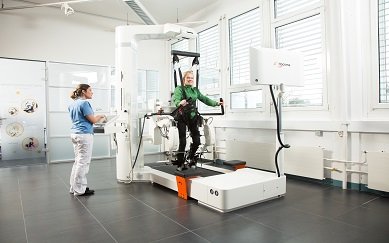Lokomat improves walking and activity in people with spinal cord injury
Hocoma
The Journal Of Neuroengineering And Rehabilitation has published a systematic review of Hocoma‘s Lokomat titled: “Robot-assisted gait training (Lokomat) improves walking function and activity in people with spinal cord injury.” Read more here.
NHS staff wishing to obtain a copy of the full text should contact their health care library. This article has been selected for inclusion in NICE Evidence Search because it meets the definition of a reliable systematic review for this service. This is a systematic review published by a journal which conforms to the Preferred Reporting Items for Systematic Reviews and Meta-Analyses (PRISMA) standard. If not published by one of these journals, a systematic review is deemed reliable if the abstract reports the inclusion/exclusion criteria, confirms two or more sources have been searched, and incorporates a synthesis of included studies.
Abstract
Robot-assisted gait training (RAGT) after spinal cord injury (SCI) induces several different neurophysiological mechanisms to restore walking ability, including the activation of central pattern generators, task-specific stepping practice and massed exercise. However, there is no clear evidence for the optimal timing and efficacy of RAGT in people with SCI. The aim of our study was to assess the effects of RAGT on improvement in walking-related functional outcomes in patients with incomplete SCI compared with other rehabilitation modalities according to time elapsed since injury. This review included 10 trials involving 502 participants to meta-analysis.
The acute RAGT groups showed significantly greater improvements in gait distance, leg strength, and functional level of mobility and independence than the over-ground training (OGT) groups. The pooled mean difference was 45.05 m (95% CI 13.81 to 76.29, P = 0.005, I2 = 0%; two trials, 122 participants), 2.54 (LEMS, 95% CI 0.11 to 4.96, P = 0.04, I2 = 0%; three trials, 211 participants) and 0.5 (WISCI-II and FIM-L, 95% CI 0.02 to 0.98, P = 0.04, I2 = 67%; three trials, 211 participants), respectively. In the chronic RAGT group, significantly greater improvements in speed (pooled mean difference = 0.07 m/s, 95% CI 0.01 to 0.12, P = 0.01, I2 = 0%; three trials, 124 participants) and balance measured by TUG (pooled mean difference = 9.25, 95% CI 2.76 to 15.73, P = 0.005, I2 = 74%; three trials, 120 participants) were observed than in the group with no intervention.
Thus, RAGT improves mobility-related outcomes to a greater degree than conventional OGT for patients with incomplete SCI, particularly during the acute stage. RAGT treatment is a promising technique to restore functional walking and improve locomotor ability, which might enable SCI patients to maintain a healthy lifestyle and increase their level of physical activity.

